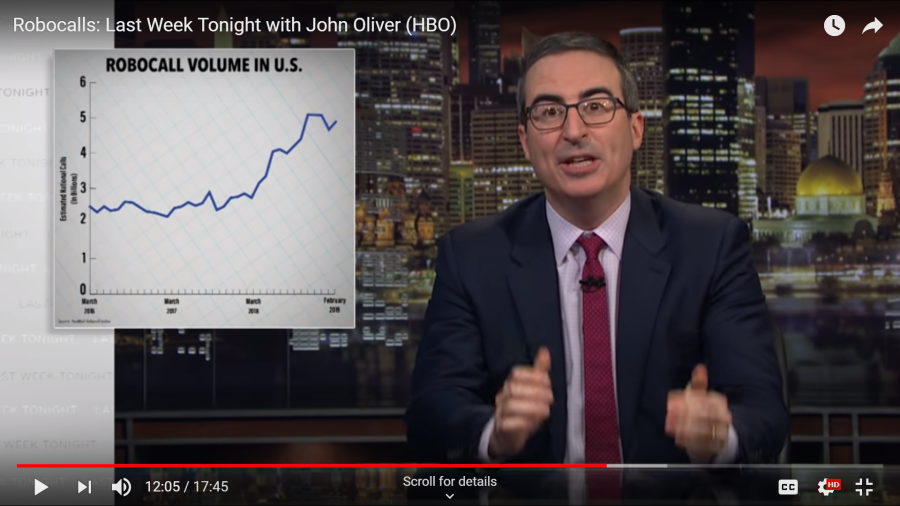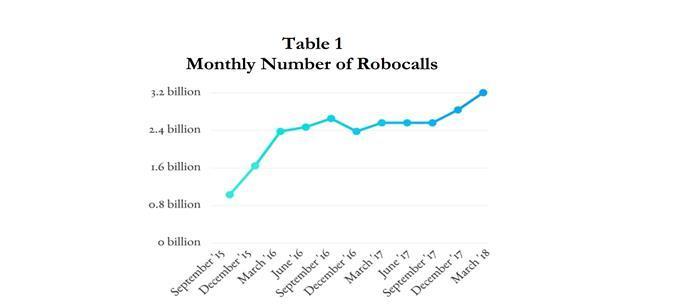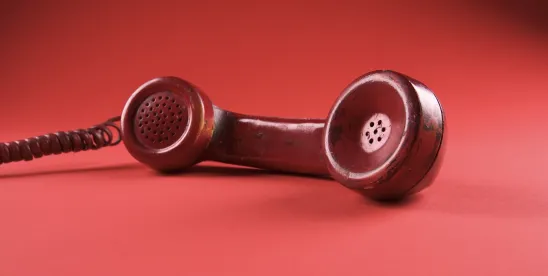Over the weekend John Oliver took on the robocall epidemic in this country with a fantastic–but potentially highly misleading– piece of advocacy on his HBO Show Last Week Tonight.
The bit was hilarious–although the language was certainly blush-inducing for those of us that don’t frequently watch late night television– and Oliver is obviously immensely talented. The bit ended with a giant foam finger pushing a giant red button to launch robocalls at the FCC encouraging it to keep Wheeler-era TCPA regulations in place. It was comedy gold and actually quite a convincing piece of advocacy. But were his various statements regarding robocalls and the federal regulations governing automated calls accurate? We here at TCPAworld.com decided to dive into the record and find out.
As you’ll see below, we’re pretty critical of a number of assertions made in the bit. We don’t mean to suggest that Oliver was intentionally misleading people–his object is to entertain after all– but given how serious the issue of TCPA reform is, reigning in potential misinformation–no matter how benign– is pretty important stuff. So–ready to dive in? here we go.
Assertion 1: Robocalls are Infuriating
TCPAworld.com Accuracy Score: Dead on accurate– sort of.
No one care for true robocalls. Random-fired spam calls are the bane of our telecommunications existence, rendering our phones close to obsolete at this point. And this is not a new problem. When the Telephone Consumer Protection Act (“TCPA”) was passed way back in 1991 Congress recognized that computerized telemarketing messages were the “scourge of modern civilization.”
The first part of the bit focuses on “true” robocalls– IRS scam calls and pre-recorded messages pitching cruises or solar panels at random. Without question, those robocalls must be stopped and Congress and the FCC must act to protect our phones.
But the bit quickly shifts away from true robocalls in a most unhelpful way and begins treating legitimate calls made by legitimate American businesses as if they were the same as random-fired spam or scam messages. As we shall see, however, this sort of sleight of hands only works to the advantage of spammers and makes an ultimate solution to the robocall epidemic more difficult to come by.
Assertion 2: Robocalls are the number one complaint to the FCC
TCPAworld.com Accuracy Score: True, but only as far as it goes.
It shouldn’t be forgotten that the FCC is not a general consumer protection organization. Its job is to facilitate interstate communications in the country. And how do we communicate interstate? Our cell phones. And what annoys us most about our cell phones? Right. Spam calls.
So unsurprisingly consumers are complaining about spam calls to the FCC–as they should. But again, watch for the bait and switch. People call the FCC complaining about scam/spam calls–true robocalls. But some people–mostly consumer lawyers– want to misapply the TCPA to legitimate businesses making calls on a volume basis (usually because they want to collect the millions in attorneys fees available in these lawsuits.) So they point to consumer “robocall” complaints to the FCC to support their lawsuits–even though those complaints are about spam calls and not legitimate calls made using modern dialers.
Again, the problem is definitional. “Robocall” complaints are generally focused on random-fired scam calls. Legitimate businesses do not make those calls. But consumer lawyers want to sue legitimate businesses. So they label all calls made using automated dialers “robocalls” and act as if consumers are complaining to the FCC in legion about calls from legitimate business. Tricky tricky.
Luckily, a reputable comedian like John Oliver will see right through that bunk right?
Assertion 3: Robocalls are any call using a pre-recorded or artificial voice or any call where a machine automatically dialed your number
TCPAworld.com Accuracy Score: Dangerously inaccurate
Nooooooo! John, what are you doing man? You’re playing right into the ruse.
The bit starts with a discussion of scam robocalls, talks about all the complaints about scam robocalls to the FCC, but then offers a definition of “robocall” that includes legitimate phone calls made by legitimate businesses using efficient dialing technology. But that definition lumps in every fraud alert, account balance reminder, bill pay SMS notification, stock price update, informational servicing call and pharmacy pick up text as equivalent to IRS and foreign-language scammers. It treats informational calls to consumers who may be facing foreclosure of their residence or repossession of their vehicles as equivalent with a random-fired message pitching solar panels. Bad bad bad terrible. How can we possibly get to the root of the scam call problem with definitions that label legitimate businesses with the same terrible “robocall” mantle that we affix to vile ne’er-do-wells that pepper us with Chinese-language scam calls?
There’s even more here to unpackage. The “robocall” definition Oliver offers is actually a crib of the expanded definition of automated telephone dialing system (“ATDS”)–a highly technical legal phrase embedded within the TCPA– that was recently handed down by the Ninth Circuit Court of Appeal in Marks v. Crunch. But the MarksATDS definition is hardly the law of the land–indeed many courts have refused to follow it because it overly expands the definition of ATDS contained within the TCPA in a way that Congress did not intend. So by borrowing the Marks definition, Oliver has chosen only the broadest–and most misleading–potential definition of ATDS.
But way way more importantly–ATDS calls are not robocalls. The two concepts are absolutely not co-extensive, which is an absolutely critical point that Oliver’s bit misses entirely. Robocalls are bad scam calls. ATDS calls can sometimes be completely legitimate. So imagining a Venn diagram some ATDS calls are also robocalls–but not all calls using dialer technology are going to be the sort that lead to consumer complaints or irritation.
By conflating these terms Oliver inadvertently makes TCPA reform–a much-needed policy shift that the FCC was poised to implement– more difficult. That means more frivolous lawsuits against legitimate businesses and less focus on the true scammers out there.
Assertion 4: Legitimate American Businesses are the Top Robocallers in the Nation
TCPAworld.com Accuracy Score: Cheater cheater pumpkin eater.
This assertion is totally inaccurate and based upon inaccurate–or at least inaccurately applied–data.
Oliver’s list of top robocallers is compiled from the same list submitted by the NCLC to the FCC last year which, in turn, was compiled from the robocall index compiled by a company called YouMail.
I wondered who YouMail was and who died and made it king of defining robocalls. So I invited YouMail’s CEO Alex Quilici onto my podcast at my former firm last year to discuss. In the podcast–which can be found here— Quilici confirms that he does not actually know how calls are being placed by the companies listed by NCLC–meaning the list just contains numbers making lots of calls, not robocalls– and cannot even confirm that the calls were actually coming from those companies. He also could not confirm whether the calls were wanted or unwanted. For those reasons he lists only phone numbers on the robocall index and does not name the callers.
But special interest groups–like the NCLC–unmask the numbers and lob them at the FCC and Congress as if they were accurate. And because YouMail labels its list the “robocall index”–even though it would more accurately be called the “top makers of legitimate phone calls list”–these special interest groups label legitimate companies as the “top robocallers” in the nation. But its just not true, as I’ve explained over and over again on my old website.
We later spoke with the CEO of a rival call blocking app who explained why focusing on “unwanted” robocalls is a far more accurate measure. When you look at his data, however, only 2% of true “robocalls” are made by the legitimate businesses that top YouMail’s list.
Translation: the data Oliver relied on in labeling legitimate American businesses as the top robocallers in the country was inaccurately applied. Had he done his homework–as we did– he would have discovered that only a tiny sliver of unwanted robocalls come from those companies.
Assertion 5: Robocall Volume Exploded After A Court Decision Overturned the FCC’s Rules Expanding the TCPA
TCPAworld.com Accuracy Score: Liar liar pants on fire
This was the worst part of the bit.
Oliver states that robocalls exploded after ACA Int’l set aside the FCC’s expansion of the TCPA last year. He even throws up a blurry little graph to prove it. (Check it out at the 12:05 mark.)

But wait a second. Take a close look at that graph.
What you’ll see is that robocalls actually exploded AFTER the 2015 Omnibus Ruling expanding the TCPA and BEFORE the court set aside those rulings. Here’s a more accurate graph:

See– robocalls went up after July 10, 2015–when the Omnibus was decided–and peaked right when ACA Int’l was decided in March, 2018.
So whereas Oliver states that we had a “solution” to the robocall problem and then the courts ruined it he is just flat wrong. The FCC’s massive expansion of the TCPA did absolutely nothing to stop robocalls. The number of “robocalls” literally quadrupled following the FCC ruling that Oliver touts as a solution.
The reason is simple–the TCPA does not prevent robocalls. You can expand the statute all you want and the bad guys will keep in coming. That’s because the TCPA is only–or mostly–enforced against legitimate business, who are not causing the problem.
And that leads us to our last point.
Assertion 6: If the FCC Limits the ATDS Definition under the TCPA Robocalls Will Increase
TCPAworld.com Accuracy Score: Specious reasoning
As just shown, when the FCC expanded the ATDS definition robocalls went up. There is no reason to assume, therefore, that narrowing that same definition will have any impact on robocalls. Robocalls are going up either way.
Instead the solution to the robocall problem is recognizing that the TCPA is not–and never was–the solution to the robocall problem. By highlighting the TCPA and acting as if it is a legitimate fix to the problem Oliver is actually making it more difficult for the FCC to focus on real solutions– like carrier requirements– by forcing it to fight political battles and waste resources over an ATDS definition that does nothing but foment frivolous litigation and does not actually stop robocalls. And that doesn’t help anyone but the consumer lawyers who rake in millions in fees under the TCPA every year.
Gross.
So TCPAworld.com’s overall take: Hilarious stuff. But not particularly accurate and perhaps even counter-productive to finding a real solution to the robocall problem.
But that giant finger pushing that giant red button was cool though.




 />i
/>i

